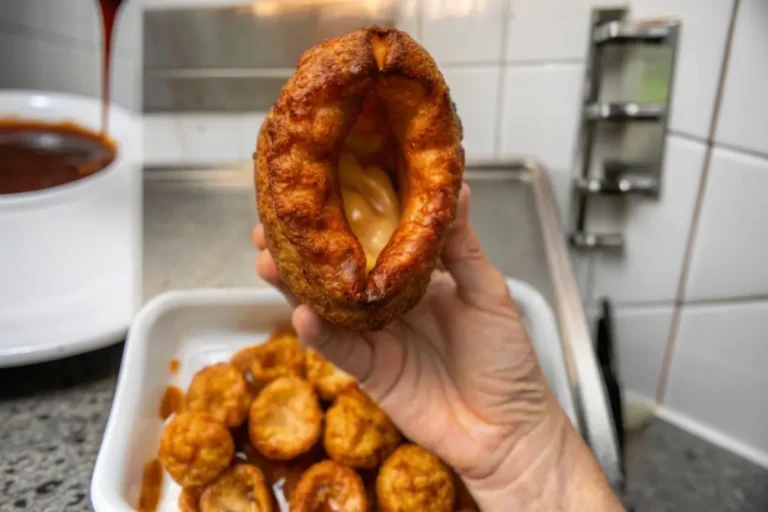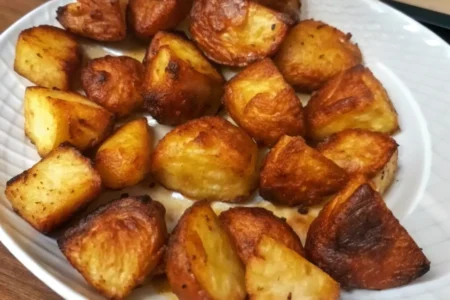It all started with a stubborn oven and a Sunday roast that nearly broke me. Picture this: the beef was resting, the gravy bubbling away, and I was standing there—oven mitts on, heart pounding—peering through the glass at twelve sad little Yorkshire puddings that had barely risen past the halfway mark. “Maybe it’s the altitude,” I muttered. But deep down, I knew. I’d winged the batter again.
That’s when I called my aunt in Yorkshire. Her advice? “Love, it’s not the oven. It’s the resting. Batter needs a nap—just like you after Christmas dinner.” And she wasn’t wrong.
Ever since, I’ve sworn by letting the batter rest overnight. It’s not just tradition; it’s kitchen magic. And today, I’m sharing everything I’ve learned about making perfect Yorkshire puddings—crispy on the outside, fluffy inside, and big enough to cradle a ladle of gravy.
The Simple Ingredients Behind Yorkshire Pudding
Let’s be honest: Yorkshire puddings look fancy, but their ingredients couldn’t be humbler. You only need:
- Eggs
- All-purpose flour
- Milk
- Water
- Salt and pepper
- And a little fat (shortening, vegetable oil, or beef drippings)
A chef once said, “Yorkshire pudding is the pauper’s soufflé.” It’s true. These golden beauties were originally served as fillers before the main meat course, stretching out expensive roasts with cheap batter. But over the centuries, they’ve earned a rightful place on the plate—especially slathered in gravy.
The Most Important Step You’re Probably Skipping
If you take away just one tip, let it be this: let your batter rest.
Sure, I’ve made puddings on the fly, skipping the fridge. They were okay. But the best ones? The ones that make you tear off a crispy piece before dinner even starts? Those rested in the fridge overnight.
Resting lets the flour absorb liquid fully and gives the gluten time to relax. Translation: taller, crispier, chewier puddings.
“If you’ve got the patience, the fridge does the work for you.” — Rick from Backyard Chef
Even a 30-minute sit on the counter helps. But if you’ve got the time, chill it overnight. It’s worth it.
The Hot Oil Trick That Never Fails
Growing up, I thought it was a culinary dare: pouring cold batter into smoking hot oil. But it’s the secret to that dramatic rise.
You’ll need muffin tins, mini cake tins, or even a big roasting tin if you’re going for the giant pub-style pudding. Add a teaspoon of fat into each well and heat the empty tin in a 230°C (450°F) oven until the oil is shimmering.
Then—and this is key—work fast but safe. Carefully pour the batter into the sizzling oil. You should hear that satisfying hiss.
Slide it straight back into the oven and don’t open the door. Not even for a peek.
Did You Know? Yorkshire Pudding Around the World
Yorkshire pudding might be an English classic, but versions of it pop up across the globe:
| Country | Similar Dish |
|---|---|
| United States | Popovers |
| Germany | Pfannkuchen (oven style) |
| Brazil | Pão de queijo (different base but similar vibe) |
| France | Gougères (cheesy cousin) |
Of course, none quite replace the satisfaction of a gravy-filled Yorkshire, but it’s fun to see batter love worldwide.
A Little Kitchen Mishap: The Exploding Tin
Once, I poured batter into a tin straight from the stovetop—forgetting the handle was screaming hot. I grabbed it bare-handed. The tin flew. Batter hit the floor. And the dog? He thought it was his lucky day.
Moral of the story: use oven mitts. Always.
How to Freeze Yorkshire Puddings Like a Pro
Ever wonder why grandma made 20 puddings when we were only five people? She was freezing them.
Yorkshire puddings freeze beautifully. Bake them, let them cool, then pop them in a zip bag and freeze. When you’re ready, warm them up in a 200°C (400°F) oven for 5 to 8 minutes.
Perfect for lazy weeknights when you still want a roast dinner vibe without the effort.
Five Ways to Serve Yorkshire Pudding Besides Roast Beef
Sure, we love them with Sunday roast. But why stop there?
- Fill with scrambled eggs and bacon for a brunch twist.
- Use as a base for pulled pork sliders.
- Serve mini puddings with mushroom cream sauce.
- Make a dessert version—drizzle with honey and berries.
- Turn into a mini taco shell (trust me: it works).
Common Yorkshire Pudding Mistakes and How to Avoid Them
Want to dodge soggy, flat puddings? Here’s what to watch out for.
Cold oil
If the oil isn’t hot enough, the batter won’t puff. Heat it until it’s almost smoking.
Opening the oven door
Resist the urge. Every peek drops the temp, ruining the rise.
Underfilling or overfilling tins
Aim for half to three-quarters full. Too little and they won’t climb; too much and they’ll spill over.
A Few Words From My Yorkshire Cousin
When I asked my cousin in Leeds how she gets hers so perfect, she laughed: “You lot down south are too gentle with it. Don’t be shy. Hot fat, cold batter, and leave it alone.”
It’s tough love, but she’s right.
Quick Recipe Recap
Here’s a no-fuss rundown.
- Make batter: whisk 8 eggs, 2 cups flour, salt, pepper, 2½ cups milk, splash of water.
- Rest: fridge overnight or at least 30 minutes.
- Heat oven: 230°C (450°F). Put 1 teaspoon oil in each tin well. Heat till smoking.
- Pour batter carefully: half to three-quarters full.
- Bake: 23 to 30 minutes. Don’t open oven.
- Serve hot: with gravy, or however you fancy.
Fun Fact: Yorkshire Pudding Day
Yes, it exists. National Yorkshire Pudding Day is celebrated every first Sunday in February in the UK. Another reason to make a big batch.
A Side of Mustard (Optional, but Recommended)
My secret indulgence? I smear a Yorkshire with a dab of English mustard before pouring in gravy. It adds a tangy bite that cuts through the richness.
A chef friend once joked, “You can tell a true Northerner by the mustard.” I’ll take that badge with pride.
The Joy of Sharing
At the end of the day, Yorkshire pudding is more than a side dish. It’s a little bit of nostalgia, a lot of comfort, and a guaranteed way to get everyone reaching for seconds.
It’s standing by the oven, waiting for that perfect rise. It’s tearing off a corner while they’re still hot. It’s hearing “save me one” from the next room.
And honestly? It’s the simplest reminder that some of the best things in life start with flour, eggs, and a little patience.
Now if you’ll excuse me, I’ve got a tray in the oven—and a jar of mustard waiting.
Print
The Secret to Golden, Puffy Yorkshire Puddings Every Time
This Yorkshire pudding recipe delivers tall, crispy, fluffy puddings every time, using simple ingredients and a few key tricks passed down from generations. Perfect for Sunday roast or creative fillings, with helpful tips for freezing and serving.
- Total Time: 35 minutes
- Yield: 12 medium Yorkshire puddings 1x
Ingredients
-
8 large eggs
-
2 cups all-purpose flour
-
2½ cups whole milk
-
Splash of water
-
1 teaspoon salt
-
½ teaspoon pepper
-
Shortening, vegetable oil, or beef drippings (1 teaspoon per tin well)
Instructions
-
In a large mixing bowl, whisk eggs, flour, salt, and pepper together. Slowly add milk and water, whisking until smooth.
-
Cover the batter and let it rest in the fridge overnight (or at least 30 minutes on the counter).
-
Preheat oven to 230°C (450°F). Place 1 teaspoon of fat into each muffin tin well and heat in the oven until oil is very hot and shimmering.
-
Carefully pour batter into the hot oil, filling each well halfway to three-quarters full. You should hear a sizzle.
-
Quickly return tin to oven and bake for 23 to 30 minutes until puddings are tall, golden, and crisp. Do not open the oven door while baking.
-
Remove from oven and serve hot with gravy, or cool and freeze for later.
Notes
-
Resting the batter overnight improves texture and rise.
-
Always heat oil until nearly smoking before adding batter.
-
Yorkshire puddings freeze well: reheat at 200°C (400°F) for 5–8 minutes.
- Prep Time: 10 minutes
- Cook Time: 25 minutes
- Cuisine: British






